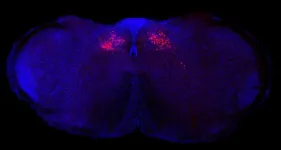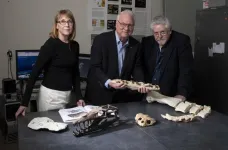(Press-News.org) NEW YORK, NY — The brain can direct the immune system to an unexpected degree, capable of detecting, ramping up and tamping down inflammation, shows a new study in mice from researchers at Columbia's Zuckerman Institute.
"The brain is the center of our thoughts, emotions, memories and feelings," said Hao Jin, PhD, a co-first author of the study published online today in Nature. "Thanks to great advances in circuit tracking and single-cell technology, we now know the brain does far more than that. It is monitoring the function of every system in the body."
Future research could identify drugs that can target this newfound brain circuit to help treat a vast range of disorders and diseases in which the immune system goes haywire.
"This new discovery could provide an exciting therapeutic venue to control inflammation and immunity," said Charles S. Zuker, PhD, the study's senior author, a principal investigator at Columbia's Zuckerman Institute and a Howard Hughes Medical Institute investigator.
Recent work from the Zuker lab and other groups is revealing the importance of the body-brain axis, a vital pathway that conveys data between the organs and the brain. For example, Dr. Zuker and his colleagues discovered that sugar and fat entering the gut use the body-brain axis to drive the craving and strong appetite for sugary and fatty foods.
"We found all these ways in which the body is informing the brain about the body's current state," said co-first author Mengtong Li, PhD, a postdoctoral researcher in the Zuker lab. “We wanted to understand how much farther the brain's knowledge and control of the body's biology went.”
The scientists looked for connections the brain might have with inflammation and innate immunity, the defense system shared by all animals and the most ancient component of the immune system. Whereas the adaptive immune system remembers previous encounters with intruders to help it resist them if they invade again, the innate immune system attacks anything with common traits of germs. The relative simplicity of innate immunity lets it respond to new insults more quickly than adaptive immunity.
Prior studies in humans revealed that electrically stimulating the vagus nerve — a bundle of thousands of nerve fibers linking the brain and the body's internal organs — could reduce the response linked to a specific inflammatory molecule. However, much remained unknown about the nature of this body-brain system: for instance, the generality of the brain’s modulation of immunity and the inflammatory response, the selective lines of communication between the body and the brain, the logic of the underlying neural circuit, and the identity of the vagal and brain components that monitor and regulate inflammation.
The Zuker lab turned to a bacterial compound that sets off innate immune responses. The scientists found that giving this molecule to mice activated the caudal nucleus of the solitary tract, or cNST, which is tucked inside the brainstem. The cNST plays a major role in the body-brain axis and is the primary target of the vagus nerve.
The scientists showed that chemically suppressing the cNST resulted in an out-of-control inflammatory response to the immune insult: levels of pro-inflammatory molecules released by the immune system were more than three times higher than usual, and levels of anti-inflammatory immune compounds were roughly three times lower than normal. In contrast, artificially activating the cNST reduced pro-inflammatory molecule levels by nearly 70 percent and increased anti-inflammatory chemical levels almost tenfold.
“Similar to a thermostat, this newfound brain circuit helps increase or decrease inflammatory responses to keep the body responding in a healthy manner,” said Dr. Jin, who started this study as a postdoctoral researcher in Dr. Zuker’s lab. Dr. Jin is now a tenure track investigator at the National Institute of Allergy and Infectious Diseases. "In retrospect, it makes sense to have a master arbiter controlling this vital response."
Previous vagus nerve stimulation research in humans suggests the findings go beyond mice. The new research may also be in line with thousands of years of thought on the potential importance of the mind on the body.
“A lot of psychosomatic effects could actually be linked to brain circuits telling your body something," Dr. Jin noted.
The scientists identified the specific groups of neurons in the vagus nerve and in the cNST that help detect and control pro- and anti-inflammatory activity. "This opens up a new window into how the brain monitors and modulates body physiology," said Dr. Zuker, a professor of biochemistry, molecular biophysics and neuroscience at Columbia's Vagelos College of Physicians and Surgeons.
Discovering ways to control this newfound brain circuit may lead to novel therapies for common auto-immune diseases such as rheumatoid arthritis, type I diabetes, multiple sclerosis, neurodegenerative diseases, lupus, inflammatory bowel disease and Crohn's disease, as well as conditions such as long COVID syndrome, immune rejection of transplanted organs, and the potentially deadly outbursts known as cytokine storms that COVID infections can trigger.
Autoimmune diseases may affect roughly one in 10 individuals, a 2023 Lancet study suggested. In the United States alone, autoimmune diseases may cost the economy $100 billion annually, a figure that may be a gross underestimate, according to the Autoimmune Association.
Harnessing the activity of this circuit may make a difference across a broad range of conditions affecting the immune system, and help treat dysregulated inflammatory states in people suffering from immune diseases and disorders, Drs. Jin and Li said.
###
The paper, "A body-brain circuit regulating body inflammatory responses," was published online in Nature on May 1, 2024.
The full list of authors includes Hao Jin, Mengtong Li, Eric Jeong, Felipe Castro-Martinez and Charles S. Zuker.
Hao Jin and Charles S. Zuker are co-inventors in a patent application describing this work. Charles S. Zuker is a scientific co-founder of Kallyope and Cajal Neurosciences. The other authors declare no conflicts of interest.
END
A University of Queensland researcher has found molecular doorways that could be used to help deliver drugs into the brain to treat neurological disorders.
Dr Rosemary Cater from UQ’s Institute for Molecular Bioscience led a team which discovered that an essential nutrient called choline is transported into the brain by a protein called FLVCR2.
“Choline is a vitamin-like nutrient that is essential for many important functions in the body, particularly for brain development,” Dr Cater said.
“We need to consume 400-500 mg of choline ...
DALLAS, May 1, 2024 — Each year, approximately 800,000 people in the U.S. have a stroke.[1] Six local stroke heroes from across the country are being recognized by the American Stroke Association, a division of the American Heart Association, for their resiliency and dedication in the fight against stroke.
The American Stroke Association’s annual Stroke Hero Awards honors stroke survivors, health care professionals, advocates and caregivers. During May, American Stroke Month, the Association, ...
During sleep, the brain weakens the new connections between neurons that had been forged while awake – but only during the first half of a night’s sleep, according to a new study in fish by UCL scientists.
The researchers say their findings, published in Nature, provide insight into the role of sleep, but still leave an open question around what function the latter half of a night’s sleep serves.
The researchers say the study supports the Synaptic Homeostasis Hypothesis, a key theory on the purpose of sleep which proposes that sleeping acts as a reset for the brain.
Lead author Professor Jason Rihel (UCL Cell & Developmental Biology) said: “When we are awake, ...
DALLAS (SMU) – An SMU-led research team has found that ancient rocks and fossils from long-extinct marine reptiles in Angola clearly show a key part of Earth’s past – the splitting of South America and Africa and the subsequent formation of the South Atlantic Ocean.
With their easily visualized “jigsaw-puzzle fit,” it has long been known that the western coast of Africa and the eastern coast of South America once nestled together in the supercontinent Gondwana — which broke off from the larger landmass of Pangea.
The research team says the southern coast of Angola, where they dug up the samples, arguably provides the most complete ...
Better than expected life expectancy in two disadvantaged areas in England is probably due to population change according to local residents and professionals.
In the UK, people from the most disadvantaged areas can expect to die nine years earlier compared with people from the least disadvantaged areas while people in the north of England have lower life expectancy, higher infant mortality and worse health and wellbeing compared with national averages.
The study, funded by the NIHR School for Public Health Research, was a collaboration between Lancaster University, ...
An international collaborative research team, including scientists from UQ’s Queensland Brain Institute (QBI), has discovered a novel mechanism underlying memory involving rapid changes in a specific DNA structure.
The team found that G-quadraplex DNA (G4-DNA) accumulates in neurons and dynamically controls the activation and repression of genes underlying long-term memory formation.
In addition, using advanced CRISPR-based gene editing technology, the team revealed the causal mechanism underlying the regulation ...
WASHINGTON, D.C. – Today, the STEMM Opportunity Alliance (SOA) announced STEMM Equity and Excellence 2050: A National Strategy for Progress and Prosperity at the 2024 White House Summit on STEMM Equity and Excellence, co-hosted by the White House Office of Science and Technology Policy (OSTP). The overarching goal of the national strategy is to help 20 million people from historically excluded and marginalized communities enter, contribute to, and thrive in Science, Technology, Engineering, Mathematics and Medical (STEMM) fields.
SOA ...
Washington, D.C.—Scientists have discovered that calcium plays a significant role in enhancing the resistance of potato plants to bacterial wilt. This disease causes worldwide losses of potatoes costing $19 billion per year. The findings open up new avenues for integrated disease management strategies, including the potential for calcium amendments to soil as a part of a comprehensive approach to controlling bacterial wilt in potatoes. The study is published in Applied and Environmental Microbiology, a journal of the American Society for Microbiology.
Ralstonia solanacearum species complex (RSSC) is a phytopathogenic bacterial group that causes bacterial wilt in ...
Social media. The climate crisis. Political polarization. The tumult of a pandemic and online learning. Teens today are dealing with unprecedented stressors, and over the past decade their mental health has been in sustained decline. Levels of anxiety and depression rose after the onset of the COVID-19 pandemic. Compounding the problem is a shortage of mental health providers — for every 100,000 children in the U.S., there are only 14 child and adolescent psychiatrists.
In response to this crisis, University of Washington researchers studied whether virtual reality might help reduce stress ...
Bethesda, MD (May 1, 2024) — The American Gastroenterological Association (AGA) has announced the 2024 recipients of its annual recognition prizes, given in honor of outstanding contributions and achievements in gastroenterology.
"AGA is delighted to present the recipients chosen for the 2024 AGA Recognition Prizes. We extend our gratitude to all the nominators for their submission of nomination letters, and to the diligent selection committee members for their work in identifying these exceptional individuals from ...




